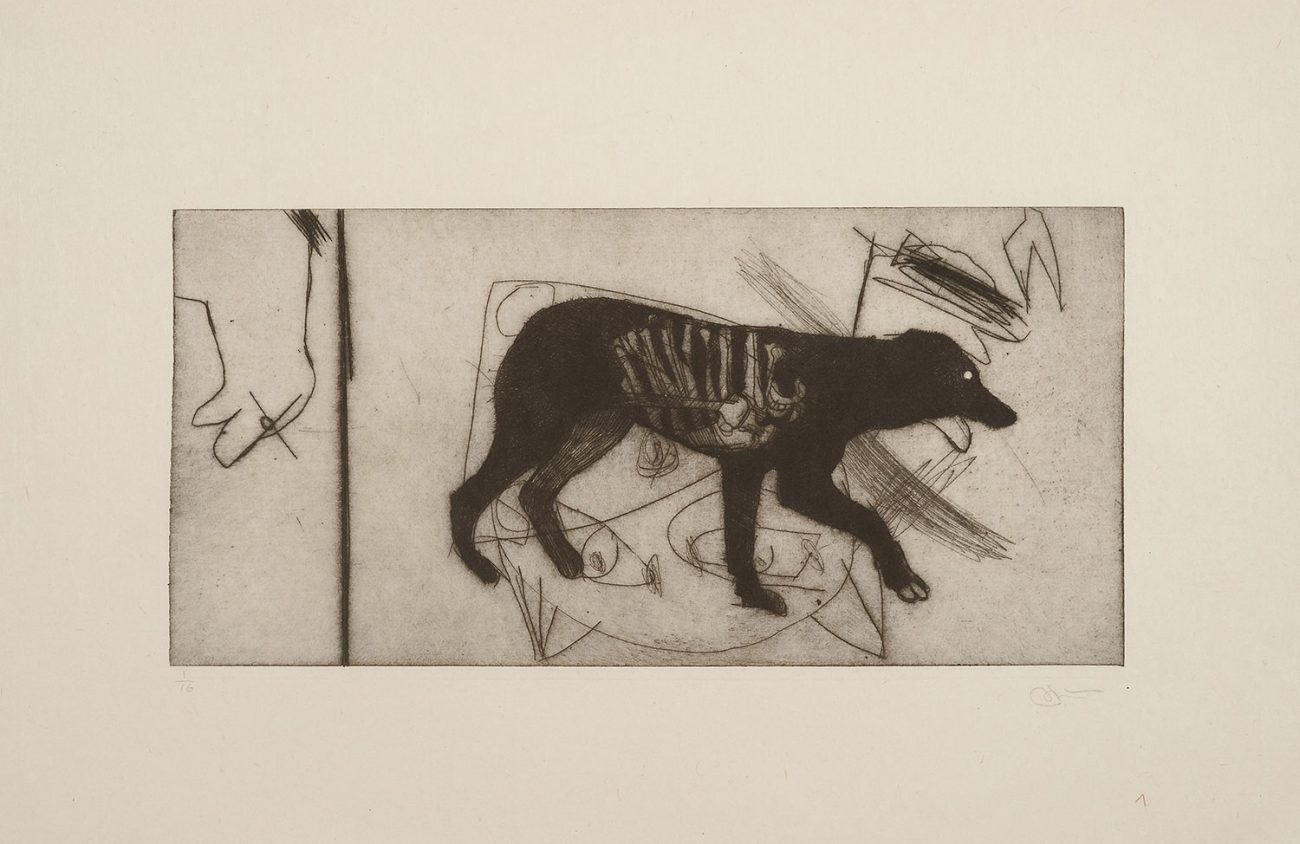Nearly 15 years ago, Eugene gallerist Karin Clarke met artist Rick Bartow for the first time at his Newport area studio. Bartow (1946-2016) was a towering figure among Native American and contemporary artists, and Clarke was eager to meet him. She found him engaging, present and genuine.
The same could be said of his collection of prints currently on display at her Karin Clarke Gallery.
Bartow’s pictures of animals are not rendered in the scientific fashion of Audubon illustrations, at least not entirely. Parts are replicated with exact precision, but some aspect in each picture — a block-in line left in, a gesture gone mad, hatching left unfinished — takes the portrait in another direction.
The prints in this show could have been done as straight portrayals of dogs, a wolf, hawks, crows and other birds. Instead, the artist chose to leave in mistakes and extra limbs, and to add gestural lines and marks seemingly not integral to the subject at hand.
In the drypoint etching “Looking Back Crow” (2001), a crow’s head and bill are drawn with exacting draftsmanship, but the lines that fill in the dark shape of the neck disappear and the bottom of the animal is not filled in. The result gives an impression that the bird is partly empty or see-through.
This X-ray approach is found most strongly, perhaps, in another drypoint, one on handmade kozo paper, called “Step Light” (2015). The subject here is a filled-in black shape, a silhouette of a dog — except its ribs are clearly outlined, making it seem like we’re looking inside the animal as well.
Playfulness underlies these images of animals. They are not serious in the photorealistic sense. The opposite is true. Beneath the dog portrayed in “Step Light” is an upside-down gesture of a different subject’s head that seems entirely out of place in terms of perspective and subject, yet fits in with the overall design.
“She Loves the Wolf” (2009) is a drypoint on handmade mitsumata paper. Whoever “she” is, her profile is tucked neatly inside the contours of a wolf. She is drawn twice: once inside the animal and once outside. The rendering of the wolf is exact except for gestural lines along the mane.
The version of the woman inside the wolf has her eyes wide open. The version drawn outside the wolf can’t see: Her eyes have been rubbed out. The repetition of the female profile depicted both inside and outside makes a masterful design. The negative space is as engaging as the imagery.
When Clarke first visited Bartow’s studio, she asked the artist if he would be interested in showing his work at her gallery.
“Talk to Chuck,” he told her, referring to his Portland gallerist Charles Froelick.
She did not immediately talk to Chuck. Slightly intimidated by Bartow’s directive, it took nearly 10 years before her then-gallery partner Tina Schrager contacted Froelick.
In 2015 the Jordan Schnitzer Museum of Art was assembling a 40-year retrospective of Bartow’s work titled “Things You Know but Cannot Explain.” The retrospective featured the artist’s paintings, sculptures, prints and drawings.
It seemed a good time to contact the Froelick Gallery, which asked Clarke and Schrager how they’d feel about showing just Bartow’s prints. They felt great about it.
Although Schrager no longer works with Clarke, she went with her to Portland to select the prints for this new exhibit, as she did for the gallery’s first show in 2015. “Animal Spirits” is the third exhibit of Bartow’s work at the Karin Clarke Gallery.
Born in Newport, Bartow was a local Oregon artist with a national reputation. According to the Froelick Gallery, his art was featured in more than 100 solo shows.
The JSMA retrospective has been to such venues as the Institute of American Indian Arts Museum of Contemporary Native Arts in Santa Fe, New Mexico, and the Heard Museum in Phoenix, Arizona, and is still traveling across the nation.
Bartow, who was affiliated with the Wiyot, Mad River Band, was also commissioned by the Smithsonian’s National Museum of the American Indian to create an outdoor sculpture facing the National Mall.
“The wooden sculptures represent traditional animals from the region’s indigenous creations stories,” according to a Smithsonian news release in 2012. The two towering poles were made out of old growth red cedar from Washington State and were driven from Newport across the country.
“By greeting our visitors with indigenous imagery using traditional and natural resources, these works represent everything our museum stands for,” said Kevin Gover, the museum’s director.
Rick Bartow: Animal Spirits is at Karin Clarke Gallery, 760 Willamette Street, through Saturday, June 29.
